Two powerful M7.6 earthquakes hit Peru-Brazil border region
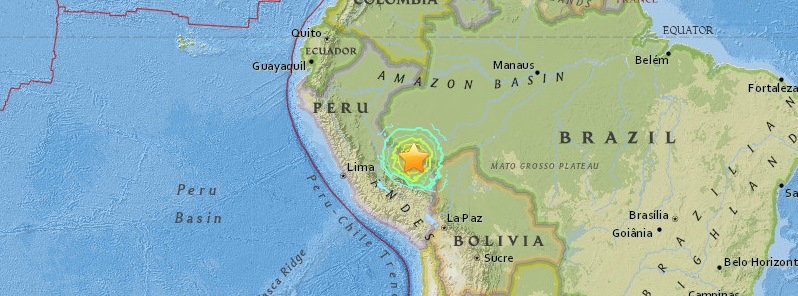
Two very strong and deep, M7.6 earthquakes (USGS) hit sparsely populated Peru-Brazil border region at 22:45 and 22:50 UTC on November 24, 2015. The agency is reporting depths of 600.6 km (373 miles) and 611.7 km (380 miles). EMSC is reporting M7.0 at a depth of 593 km (368.5 miles) and M7.2 at a depth of 627 km (389 miles).
GFZ Potsdam – GEOFON is also reporting two powerful earthquakes – M7.0 at a depth of 588 km (365 miles) and M7.3 at a depth of 613 km (381 miles).
According to the USGS, epicenter of the 22:45 UTC quake was located 173 km (107 miles) WNW of Iberia, Peru, 245 km (152 miles) WNW of Cobija, Bolivia and 247 km (153 miles) W of Brasileia, Brazil.
There are about 6 097 people living within 100 km (62 miles) radius.
USGS issued green alert level for shaking-related fatalities; there is a low likelihood of casualties. Yellow alert level was issued for economic losses. Some damage is possible and the impact should be relatively localized. Estimated economic losses are less than 1% of GDP of Peru. Past events with this alert level have required a local or regional level response.
Overall, the population in this region resides in structures that are vulnerable to earthquake shaking, though some resistant structures exist. The predominant vulnerable building types are mud wall and ductile reinforced concrete frame construction.
Recent earthquakes in this area have caused secondary hazards such as landslides that might have contributed to losses.
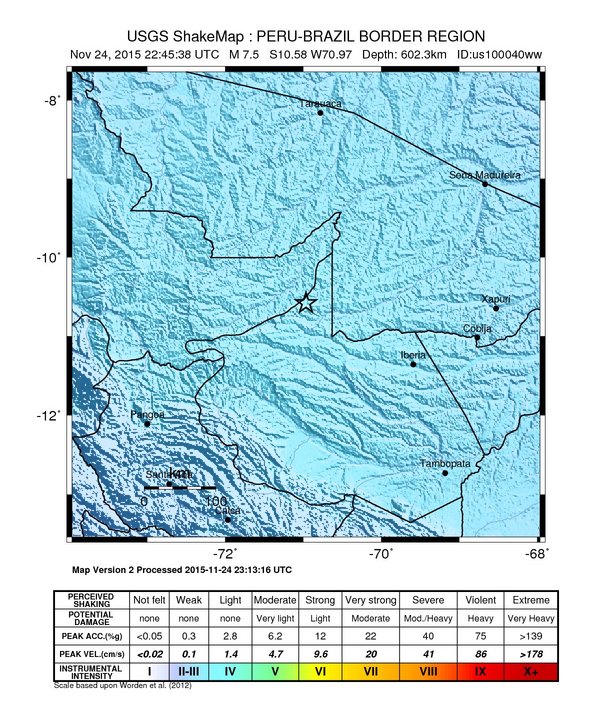
Population exposure
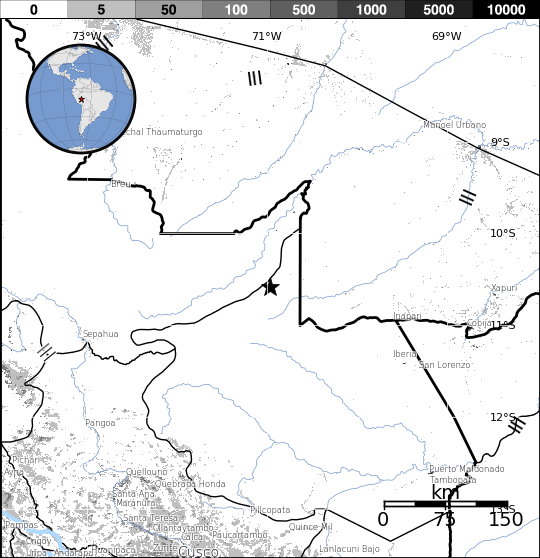
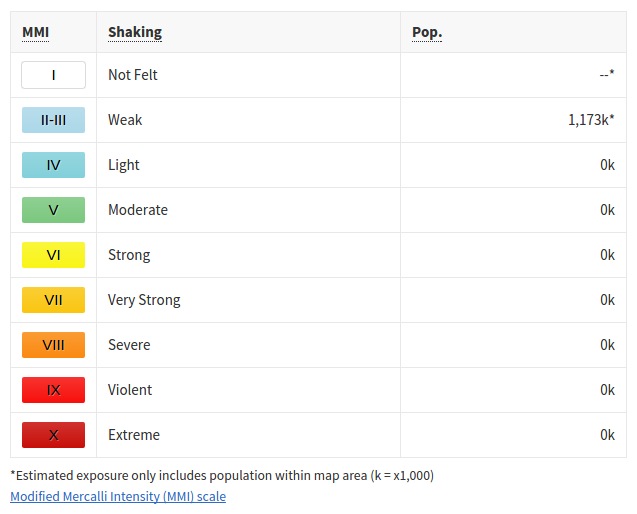
According to the USGS, both earthquakes occurred as the result of normal faulting at a depth of approximately 600 km (372 miles), almost 1 000 km (621 miles) east of the Peru-Chile Trench within the subducted oceanic lithosphere of the Nazca plate. Focal mechanisms indicate rupture occurred on either a north or south-southeast striking, moderately dipping normal fault. At the location of the earthquakes, the Nazca plate subducts to the east under the South America plate at a velocity of about 69 mm/yr.
The two events were separated by approximately 50 km (31 miles) horizontally – slightly more than typical location uncertainties of global earthquakes – and just 6 km (3.7 miles) vertically. They also had approximately the same focal mechanism. The latter earthquake was almost certainly triggered by the earlier event. Seismologists sometimes refer to a pair of similarly sized earthquakes that occur at nearly the same time and location as an earthquake "doublet."
As it descends eastwards from the Peru-Chile Trench off the west coast of Peru, the Nazca plate is seismically active down to depths of about 200 km (124.3 miles). Between depths of 200 km and 500 km (310.7 miles), where the Nazca plate subducts beneath eastern Peru, very few earthquakes are produced. Beneath Peru and Brazil in the border region near the November 24th earthquakes, the subducted Nazca plate is again seismically active between depths of about 500 km and 650 km (403.9 miles). The deep part of the Nazca plate, in which the November 24th earthquakes occurred, took 10 million years or more to descend from the point at which it initially thrust under the South America plate.
Earthquakes that have focal depths greater than 300 km (186.4 miles) are commonly termed "deep-focus" earthquakes, they cause less damage on the ground surface above their foci than similar magnitude shallow-focus earthquakes, but large deep-focus earthquakes may be felt at great distance from their epicenters.
Over the past century, 91 earthquakes with a magnitude of M7 or more have occurred at depths greater than 300 km globally; 13 of these were located in the same region as the November 24, 2015 events. The largest nearby event at these depths was the aforementioned M8.2 Bolivia earthquake. The most recent large event in the immediate vicinity of the November 24, 2015 events was a M7.0 earthquake in October 1990, 15 km (9.3 miles) to the southeast.
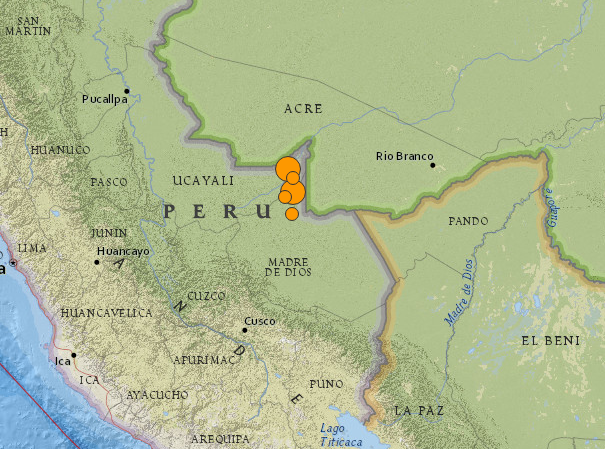
Image credit: USGS
- 4.62015-11-25 00:28:16 UTC600.0 km
- 4.52015-11-24 23:55:20 UTC616.9 km
- 4.62015-11-24 23:44:12 UTC595.1 km
- 7.62015-11-24 22:50:53 UTC611.7 km
- 7.62015-11-24 22:45:38 UTC600.6 km
Seismotectonics of South America (Nazca Plate Region)
The South American arc extends over 7,000 km, from the Chilean margin triple junction offshore of southern Chile to its intersection with the Panama fracture zone, offshore of the southern coast of Panama in Central America. It marks the plate boundary between the subducting Nazca plate and the South America plate, where the oceanic crust and lithosphere of the Nazca plate begin their descent into the mantle beneath South America. The convergence associated with this subduction process is responsible for the uplift of the Andes Mountains, and for the active volcanic chain present along much of this deformation front. Relative to a fixed South America plate, the Nazca plate moves slightly north of eastwards at a rate varying from approximately 80 mm/yr in the south to approximately 65 mm/yr in the north. Although the rate of subduction varies little along the entire arc, there are complex changes in the geologic processes along the subduction zone that dramatically influence volcanic activity, crustal deformation, earthquake generation and occurrence all along the western edge of South America.
Most of the large earthquakes in South America are constrained to shallow depths of 0 to 70 km resulting from both crustal and interplate deformation. Crustal earthquakes result from deformation and mountain building in the overriding South America plate and generate earthquakes as deep as approximately 50 km. Interplate earthquakes occur due to slip along the dipping interface between the Nazca and the South American plates. Interplate earthquakes in this region are frequent and often large, and occur between the depths of approximately 10 and 60 km. Since 1900, numerous magnitude 8 or larger earthquakes have occurred on this subduction zone interface that were followed by devastating tsunamis, including the 1960 M9.5 earthquake in southern Chile, the largest instrumentally recorded earthquake in the world. Other notable shallow tsunami-generating earthquakes include the 1906 M8.5 earthquake near Esmeraldas, Ecuador, the 1922 M8.5 earthquake near Coquimbo, Chile, the 2001 M8.4 Arequipa, Peru earthquake, the 2007 M8.0 earthquake near Pisco, Peru, and the 2010 M8.8 Maule, Chile earthquake located just north of the 1960 event.
Large intermediate-depth earthquakes (those occurring between depths of approximately 70 and 300 km) are relatively limited in size and spatial extent in South America, and occur within the Nazca plate as a result of internal deformation within the subducting plate. These earthquakes generally cluster beneath northern Chile and southwestern Bolivia, and to a lesser extent beneath northern Peru and southern Ecuador, with depths between 110 and 130 km. Most of these earthquakes occur adjacent to the bend in the coastline between Peru and Chile. The most recent large intermediate-depth earthquake in this region was the 2005 M7.8 Tarapaca, Chile earthquake.
Earthquakes can also be generated to depths greater than 600 km as a result of continued internal deformation of the subducting Nazca plate. Deep-focus earthquakes in South America are not observed from a depth range of approximately 300 to 500 km. Instead, deep earthquakes in this region occur at depths of 500 to 650 km and are concentrated into two zones: one that runs beneath the Peru-Brazil border and another that extends from central Bolivia to central Argentina. These earthquakes generally do not exhibit large magnitudes. An exception to this was the 1994 Bolivian earthquake in northwestern Bolivia. This M8.2 earthquake occurred at a depth of 631 km, which was until recently the largest deep-focus earthquake instrumentally recorded (superseded in May 2013 by a M8.3 earthquake 610 km beneath the Sea of Okhotsk, Russia), and was felt widely throughout South and North America.
Subduction of the Nazca plate is geometrically complex and impacts the geology and seismicity of the western edge of South America. The intermediate-depth regions of the subducting Nazca plate can be segmented into five sections based on their angle of subduction beneath the South America plate. Three segments are characterized by steeply dipping subduction; the other two by near-horizontal subduction. The Nazca plate beneath northern Ecuador, southern Peru to northern Chile, and southern Chile descend into the mantle at angles of 25° to 30°. In contrast, the slab beneath southern Ecuador to central Peru, and under central Chile, is subducting at a shallow angle of approximately 10° or less. In these regions of “flat-slab” subduction, the Nazca plate moves horizontally for several hundred kilometers before continuing its descent into the mantle, and is shadowed by an extended zone of crustal seismicity in the overlying South America plate. Although the South America plate exhibits a chain of active volcanism resulting from the subduction and partial melting of the Nazca oceanic lithosphere along most of the arc, these regions of inferred shallow subduction correlate with an absence of volcanic activity. (USGS) More information on regional seismicity and tectonics
Featured image credit: USGS

Commenting rules and guidelines
We value the thoughts and opinions of our readers and welcome healthy discussions on our website. In order to maintain a respectful and positive community, we ask that all commenters follow these rules:
We reserve the right to remove any comments that violate these rules. By commenting on our website, you agree to abide by these guidelines. Thank you for helping to create a positive and welcoming environment for all.